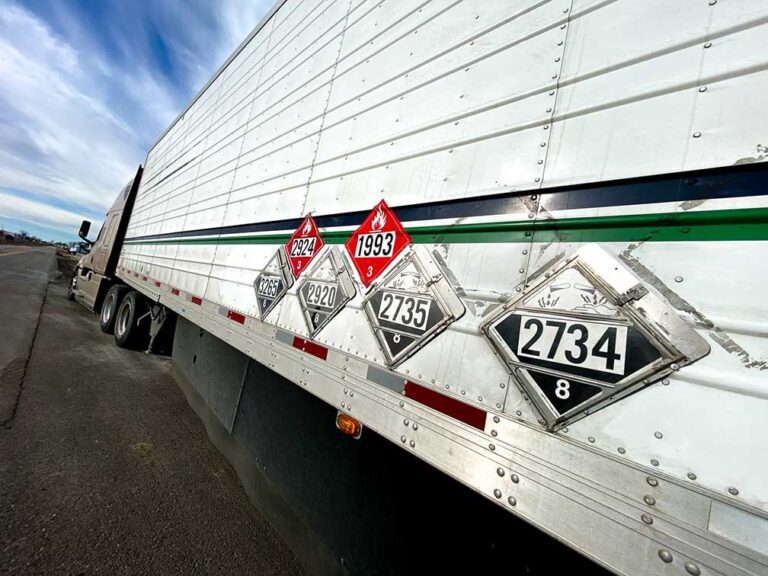While a commercial driver’s license (CDL) is required for all operators of commercial trucks, not every professional driver undergoes the certification and training required to haul hazardous materials (hazmat). Hazmat haulers must meet additional requirements and standards for safety.
However, the hazmat certification is not always required, and any driver may be called upon to transport hazardous materials at some point. This is when the Emergency Response Guidebook (ERG) is needed. If you went through driver orientation with a motor carrier, you likely received a stack of guidebooks during training. Remember the one with the bright orange cover? That’s the ERG — and you want to make sure you know where it is.
The most important thing to understand about the emergency regulations belong with the bill of lading and other shipping documents whenever a load is placarded for hazardous materials. Federal regulations require that shipping paperwork must include emergency information. In other words, it’s the shipper’s responsibility.
If emergency responders, such as law enforcement or fire department personnel, are required to attend your vehicle for any reason — like an accident, a fire or a hazmat leak — they’ll need to know what substances they’re dealing with and the proper way to handle the situation. That information is included in the ERG. It’s the driver’s job to make sure the ERG gets to those responders.
Of course, most drivers know that affixing hazmat placards to the trailer greatly increase the likelihood of being selected for a DOT (Department of Transportation) inspection. And, even though it’s the shipper’s responsibility to provide paperwork specific to the material being transported, when a roadside inspection reveals a discrepancy, it’s the driver who stands to get cited. If the shipper fails to include emergency response information, the ERG fills the requirement, potentially preventing you from having a ticket and fine on your record.
If you’re one of those drivers who wants to know as much as possible about their cargo and maintain the highest levels of safety, you’ll want to know more about the ERG. It’s important to understand that the little orange ERG book is far different than the pocket-sized copy of the Federal Motor Carrier Safety Regulations (FMCSRs) that many carriers hand out.
The FMCSR book has two main functions. First, since drivers are responsible for following the regulations that pertain to them, it’s good to have a copy for reference. Some drivers frequently look up various rules to make sure they understand them. The second reason is that carriers have a defense if they’re accused of not educating their drivers about the regulations. By providing those regulations to each driver, they strengthen their defense in any actions involving the rules.
The ERG, on the other hand, is provided as a safeguard, just in case a shipper doesn’t include emergency response information along with the bill of lading, as they are required to do. Drivers are supposed to make sure that information is included when signing the paperwork. Unfortunately, when the shipper hands the driver an inch-high stack of paper, it can be difficult to figure out what’s in the stack. Most drivers simply sign where they’re told and get on with the load. Keeping the ERG close at hand is insurance for the driver, in case the required information isn’t included or isn’t complete.
When hauling a placarded load, drivers are required to leave the load paperwork on the driver’s seat or in a door pouch when they’re out of the truck. That’s where the ERG goes, too. The idea is that if there’s a problem while the driver is gone, the police or fire department know where to find the information they need. That information includes these items:
- The correct name and description of the hazardous material.
- Any immediate health hazards, such as inhalation hazard.
- Will it burn? Will it explode? Can water be used to put it out?
- First aid procedures for anyone exposed to the substance.
- Evacuation guidance. Is it necessary? How large an area to evacuate?
- Other hazards, such as harm to fish or wildlife if it gets into a stream.
All this information is available in the ERG. The guide isn’t difficult to use, and the different sections are color-coded. Here are the basics:
- The blue section is simply a list of hazardous substances in alphabetical order.
- The yellow section is another list of hazardous substances, listed by their UN or NA identification numbers. This is helpful for quick identification of a substance based on the number on the placards or on the shipment manifest.
- The orange section contains the guides for each substance. Listings for each material in the blue or yellow sections provide a guide number, making it easy to look the correct guide.
- Green pages contain evacuation information about each substance, whether evacuation of the public is necessary and, if so, what area needs to be evacuated.
Although there are apps that contain emergency response information — including an app version of the ERG itself — electronic versions are not lawful for inclusion with the load paperwork. The information MUST be printed.
While the information in the ERG is primarily for the use of first responders, as the driver, your own response to an accident, fire or other threat can be more effective if you know about the substances you’re carrying. If, for example, there’s an inhalation hazard, you can direct people away from your vehicle before emergency responders even get there. The ERG can help you decide if you should remain with the vehicle or get everyone far away.
Some drivers go as far as to put a bookmark in the ERG at the correct page, saving emergency responders valuable seconds when dealing with an issue. Knowing what’s in that trailer can help you make better decisions about your route, parking and more.
If you’re like most drivers, you stashed those books you received in orientation somewhere in the truck and haven’t thought about them since. Understandably, not every driver enjoys recreational reading — and government regulations aren’t the most riveting stories, anyway. The ERG, however, packs a lot of useful information and just might save you the cost of a citation, or even save a life.
Cliff Abbott is an experienced commercial vehicle driver and owner-operator who still holds a CDL in his home state of Alabama. In nearly 40 years in trucking, he’s been an instructor and trainer and has managed safety and recruiting operations for several carriers. Having never lost his love of the road, Cliff has written a book and hundreds of songs and has been writing for The Trucker for more than a decade.








